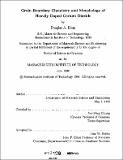| dc.contributor.advisor | Yet-Ming Chiang. | en_US |
| dc.contributor.author | Blom, Doughas A. (Douglas Allen), 1971- | en_US |
| dc.date.accessioned | 2005-08-19T18:41:27Z | |
| dc.date.available | 2005-08-19T18:41:27Z | |
| dc.date.copyright | 1998 | en_US |
| dc.date.issued | 1998 | en_US |
| dc.identifier.uri | http://hdl.handle.net/1721.1/9580 | |
| dc.description | Thesis (Sc.D.)--Massachusetts Institute of Technology, Dept. of Materials Science and Engineering, 1998. | en_US |
| dc.description | Includes bibliographical references (p. 135-142). | en_US |
| dc.description.abstract | Ceria is a model system for oxygen ion conducting ceramics of the cubic fluorite structure, in which grain boundaries are known to limit the overall ionic conductivity of polycrystals. Measurements of grain boundary segregation of the aliovalent dopants Gd3+ and Ta5+ in heavily doped ceria have been made using a Vacuum Generators HB603 scanning transmission electron microscope (STEM). Space charge models both at the dilute limit, and with a limited site density at the interface, have been applied. In addition, a number of adsorption models have been considered. The segregation isotherms of singly doped compositions allow one to determine the majority driving force for Gd3+ and Ta5+ ions in ceria. Gd3+ segregation is driven primarily by electrostatic interactions as described by a limited-site space charge model which explicitly considers the site density available at the interface. Ta5 + segregation in ceria is primarily associate, 1 with adsorption effects due to elastic strain relaxation. From the singly doped compositions one cannot determine whether a space charge exists in Ta5?? doped ceria, nor the contribution of adsorption to Gd3+ segregation in ceria. In co-doped samples, it becomes possible to study co-segregation effects between Gd3+ and Ta5+, as well as the minority segregation driving force(s). Specifically, by changing the lattice defect chemistry, the space charge potential ... changes, allowing for the separation of elec:trostatic and adsorption driving forces. Ta5 + segregation was significantly depressed in co-doped compositions, indicating a negative ... effect of Gd3+ ions on Ta5+ ions in ceria. Gd3+ segregation was successfully modeled by a limitedsite space charge model. Ta5+ additions did not affect the level of Gd3+ segregation in co-doped ceria. Grain boundariet:i observed with HREM in Ta5+ containing ceria often contained an arrwrphous siliceous phase, while all boundaries observed in Gd3+ doped samples were free of secondary phase. The solubility of Si in ceria is strongly influenced by aliovalent dopants. Amorphous intergranular silicate films were observed in Ta5 + doped ceria with less Si impurity than Gd3+ doped samples which WP.re film-free. The adsorption of Tar,+ to the grain boundary core promotes the formation of Si containing amorphous films. Gd3 + segregation in a space charge does not. Confirmation of a space-charge in acceptor-doped ceria allows for the explanation of grain boundary blocking effects in materials without amorphous intergranular films. Acceptor-doped fluorite structure oxides will have grain boundaries with a net positive charge balanced by a negative space charge layer. Positively charged defects such as Vo will be depleted in the near grain boundary space charge and it is proposed that this depletion is responsible for the blocking nature of grain boundaries in fluorite etructure oxides. | en_US |
| dc.description.statementofresponsibility | by Douglas A. Blom. | en_US |
| dc.format.extent | 142 p. | en_US |
| dc.format.extent | 7138792 bytes | |
| dc.format.extent | 7138550 bytes | |
| dc.format.mimetype | application/pdf | |
| dc.format.mimetype | application/pdf | |
| dc.language.iso | eng | en_US |
| dc.publisher | Massachusetts Institute of Technology | en_US |
| dc.rights | M.I.T. theses are protected by copyright. They may be viewed from this source for any purpose, but reproduction or distribution in any format is prohibited without written permission. See provided URL for inquiries about permission. | en_US |
| dc.rights.uri | http://dspace.mit.edu/handle/1721.1/7582 | |
| dc.subject | Materials Science and Engineering | en_US |
| dc.title | Grain boundary chemistry and morphology of heavily doped cerium dioxide | en_US |
| dc.type | Thesis | en_US |
| dc.description.degree | Sc.D. | en_US |
| dc.contributor.department | Massachusetts Institute of Technology. Department of Materials Science and Engineering | en_US |
| dc.identifier.oclc | 42076449 | en_US |

